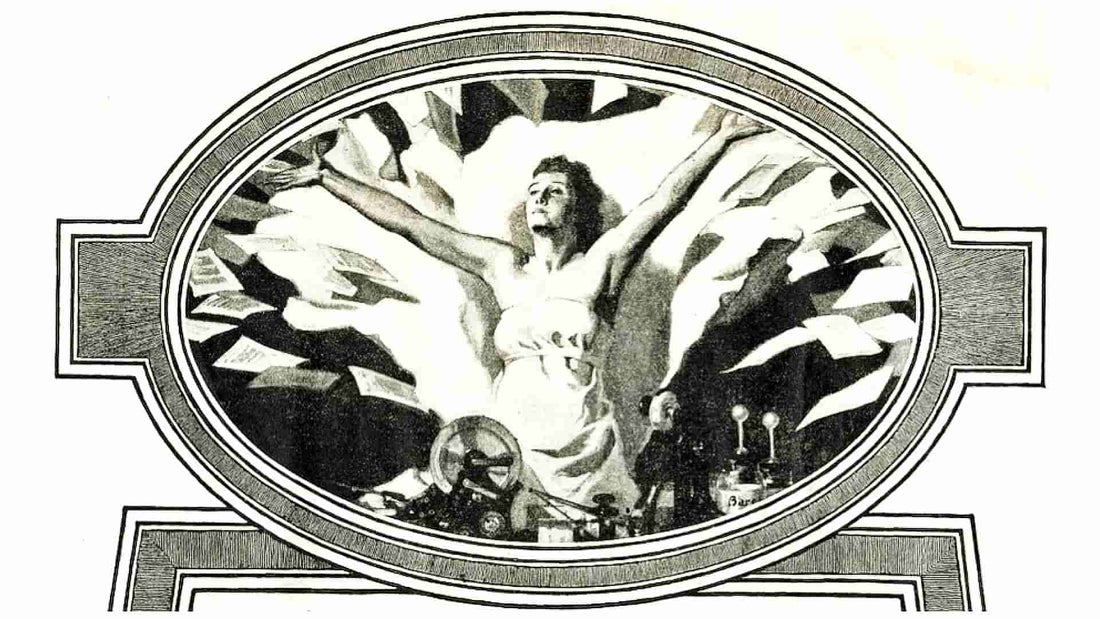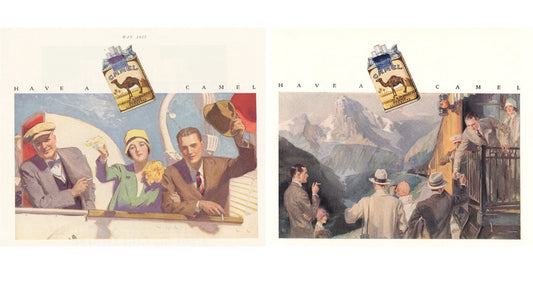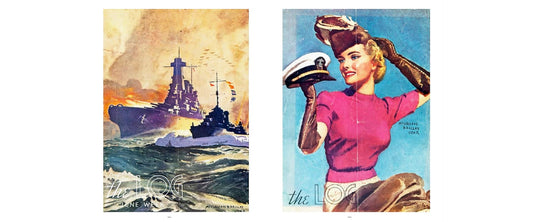
Art Deco Design Influence in McClelland Barclay's Works
Share
The Art Deco design influence was at its apex in New York during the 1920s and 1930s. This is exactly when artist McClelland Barclay was creating his greatest range of works from his Manhattan studio in the Crown Building on 57th Street at 5th Avenue.
He may have literally been looking out the window to see the Chrysler Building and Rockefeller Center being built in 1929-33 only a few blocks away. Likely he would have seen how architects were adding stylized decorative elements to their skyscrapers. He would have noticed the lean streamline modern look spilling over into furniture and decor, film sets and fashion. This was an exciting and new design style that we now know as Art Deco. And I expect he was looking for opportunities to apply this in his own way in commercial illustration work.
Not all Barclay's works followed the Art Deco design aesthetic, but I can see the motifs and streamlined modern influences of the movement that was all around him. Here's a look at the Art Deco influence in some of McClelland Barclay's diverse range of art works spanning 1919 - 1939.
Art Deco Style in Machine Age Advertising Art
 |
 |
Art Deco influenced illustrations by McClelland Barclay, L: A.B. Dick, 1919 via magazineart.org; R: US Gypsum Sheetrock, 1920
Some of Barclay's earliest commercial works advertised business, building or industrial products in magazines. The 1919 illustration detail above was for A. B. Dick Company featuring a goddess-like woman presiding over business machinery and tossing papers in the air. A.B. Dick was a major American manufacturer of copy machines and office supplies. This ad was for a mimeograph machine, a precursor to the office photocopier, (full ad in LIFE June 5, 1919 is shown left).
This illustration reflects the celebration of the machine; a key theme of the Art Deco movement. It was also a fairly rare opportunity for Barclay to be able to include a woman in his commercial art usually constrained by the communication objectives of the client and the limitations of black and white printing. Up to this point in his career as an illustrator, Barclay works were most often commissioned for industrial companies such as Arco, Glidden, Westinghouse and U.S. Gypsum (Sheetrock ad right, and centre detail) through various advertising agencies he worked for in New York, Buffalo, Detroit and Chicago.

McClelland Barclay illustration of man & machine for Cadillac, Good Housekeeping Feb 1926
Embracing Art Deco for Everyone
I find it most interesting that this American Art Deco artist was creating works exemplifying the modernist ideal espoused by architects Walter Gropius and Le Courbusier. They believed that good design could be applied to mass production and made accessible to all. One of the aspects of Art Deco was the use of machines and materials to make all kinds of products affordable.
Unlike the high-priced and exclusive hand-crafted decorative wares exhibited at the 1925 Exposition Internationale des Arts Decoratifs in Paris, much of Barclay's advertising art, and his own signature decor and jewellery products were meant for the mainstream masses in a fast-changing America.
Art Deco America in Motion
From 1916 to well into the 1930s, Barclay illustrated ads for the new exciting modes of personal transportation: the airplane and automobile. As I explain in my biography of the artist, he painted social tableaux, injecting fashion and females in scenes alongside the products. The Art Deco era fascination with speed and flight coincided with post-war industrial recovery refocused on consumer products. His ads for Dayton-Wright airplanes were aimed at the elite traveller able to afford personal aircraft. But Barclay also used the idea of flight and many other active transportation themes to sell upwardly mobile middle-class Americans automobiles, fuel and tires.
 |
 |
McClelland Barclay Art Deco ads, L: Goodyear 'Bluestreak' tires, Saturday Evening Post, 1917; R: Body by Fisher, LIFE, 1927
From 1922 to 1931, McClelland Barclay illustrated hundreds of magazine ads for Detroit-based Fisher Body Company. It was one of the seven founding brothers of the auto body manufacturer who hired Barclay. Fisher Bodies' assembly lines produced the exterior and newly enclosed interior 'fashion' for many car models. Fisher Bodies became integral to looks and marketing of General Motors' growing stable of brands. The Fisher emblem of a Napoleonic carriage was the trademark logo on the cars and ads. But it was Barclay's illustrations which brought the ads to life. His fashionable, youthful Fisher Body Girl, helped to attract women and their influence on men in purchasing and driving a Buick, Cadillac, Pontiac or Chevrolet.

McClelland Barclay fashionable illustration for Fisher Body ad in Ladies' Home Journal, Apr 1925
Barclay's signed illustrations for Fisher Body ads evolved over nearly 10 years. Featuring ever more elongated fashionably dressed figures, his ads were metaphors for the modern style of all GM's assembly-line automobiles. His art created desire and sold imaginary adventure in motion. The fast-growing middle class American could see themselves and get noticed in a new mode of transportation.
After appearing nearly weekly in the Saturday Evening Post and monthly in numerous other magazines like Ladies' Home Journal and Redbook, both the Fisher Body Girl and McClelland Barclay were famous. This was at the same time the spectacular Art Deco Fisher Building by architect Albert Khan opened in late 1928 across the street from GM's world headquarters in Detroit.
I speculate Barclay would likely have visited and noted the building's Art Deco influenced bronze frieze with symbolic nude figures over the West Grand Boulevard main entry (shown below). He may have admired the works of metal artist Anthony Di Lorenzo on the bronze elevator doors while waiting to ride up to the 26th floor reception to meet his clients with his latest ad concept. I'm not sure that happened, but indeed it would have been a remarkable and deserved first-hand experience of Detroit's golden age Barclay had a direct hand in creating for the Fisher brothers.

Bronze decorative bronze frieze over the main entrance of the Fisher Building in Detroit, photo: K. Mogg
Perhaps the most stunning McClelland Barclay Art Deco automotive illustrations are his two editorial covers for MoToR annual magazine in 1926 and 1927. A semi-nude goddess holds up small cars (shown below) at the height of automobile euphoria and the Art Deco era during the Roaring Twenties.

|

|
High Art Deco illustrations for MoToR Annual magazine covers by McClelland Barclay, L: 1926; R: 1927
Art Deco Influence in McClelland Barclay Costume Jewellery
Art Deco design motifs include geometry, sun rays, frozen fountains and stylized lean nimble animals like birds, deer, or exotic flora and female nudes. Some of these Art Deco design themes can be found in two very different looking McClelland Barclay jewellery styles made in the late Art Deco era by Rice-Weiner & Company between 1938 and 1942.
McClelland Barclay stylized Art Deco sterling silver dove with fanned feathers and leaping dolphins brooches
McClelland Barclay signature costume jewellery was marketed for the masses at department and specialty stores. Some was made of sterling silver because of wartime material rationing, but also because sterling could be hammered from behind into all kinds of shapes using the repoussé technique. The smooth and shiny finish of sterling silver wearable art was aligned with the look popular in Art Deco architecture and objects of glass and chrome.
Completely different is the McClelland Barclay costume jewellery which features bold geometric shapes and colourful rhinestone embellishments. Gold-plating and silvertone metallic finishes replicate that of fine gold, platinum and precious gem jewellery. Mass jewellery manufacturing techniques allowed them to be offered as affordable Art Deco fashion indulgences.
 |

|
McClelland Barclay geometric square, round and rectangular shaped brooches made by Rice-Weiner Company in the late Art Deco era.
Art Deco Influence in Barclay's Metal Decorative Art Products
By the early 1930s, Barclay was a well known and independent freelance artist allowing him to move on from Fisher to other endeavours. He became sought after by advertisers, editors and film studios for his fashion taste and artistic influence.
Throughout the 1930s Barclay illustrated editorial works appeared in many mainstream magazines: monthly covers for Pictorial Review and regular serial story illustrations for Cosmopolitan. This is when he also began creating and selling metal decorative art products through his own company founded in 1930, McClelland Barclay Art Products, Inc.
Free from the commercial constraints of other works, I think the Art Deco design influence is even more apparent in Barclay's own metal decor products for the home or office, especially those of female nude figures.
 |
L: Summer nude bronze-plated wall plaque; R: Female nude bronze-plated bookends, both 1930s by McClelland Barclay Art Products, Inc.
What do you think? Are you following all the upcoming 100th anniversary events celebrating the Paris Art Deco expo? Do you have a favourite Art Deco style building, object or vintage costume jewellery item? Share your comments!










